|
|
|
They Were Good - This section of the history deals with Battalion Headquarters of "the fastest moving and working Ordnance maintenance battalion in the United States Army," a designation given the battalion by the Chief of Ordnance in Washington, D. C., through the War Department's Public Relations Bureau. So hard and successfully did the Headquarters organization operate for the efficiency of the battalion during its ETO combat days that it has been stated in a jocular vein that the daughters of the commanding officer, Lt. Col. Raymond B. Graeves Jr., have their father classified as the only hero to be produced by the State of Maryland, due to the numerous times his picture appeared in the hometown newspaper in recognition of battalion achievement. And there were many occasions for the noting of such achievement, for, during the European campaign, the 128th Armored Ordnance Maintenance Battalion, integral part of the "Super Sixth" Armored Division, was most active, travelling 2,036 miles and establishing 47 bivouacs, according to Capt. Walter G. Pilcer, Battalion S-2 and S-3. About a week before leaving Springhill, England, for the marshalling yards and the Port of Southampton, men and officers of the battalion heard Gen. Grow speak to the division at its first bowl formation. They learned from the lips of the general that they were headed for combat shortly, and listened solemnly to his warning not to take much money along, "because you won't need it now." They hoped they could live up to the name of the "Super Sixth" Armored Division. Included in the Headquarters organization were Division Ordnance, consisting of Ammunition Section, headed by Maj. Thomas J. Wood, and General Supply Section, headed by Capt. William D. Rabon and later by Capt. George R. Naas; Personnel Section, under guidance of First Lt. Albert R. Boch, later First Lt. Newland H. Holmes and finally Second Lt. James S. Tresslar; and the Medical Detachment under Capt. Alfred J. Schmitt. |
|
The Brass - Executive officer of the battalion was Maj. John S. Chambers, while Maj. Chester Stiteler officiated as battalion shop officer, and Maj. Edward J. O'Hara was parts officer. Capt. Carl L. Miller headed the Battalion S-4 Section. The original three battalion liaison officers were First Lts. Robert E. "Speedy" Callaway, Frank Haught and Frederick Stoltz. These three officers and an inspection team were under jurisdiction of Maj. Stiteler. In the usual army system of shifting and changing, the officers' places were taken by First Lts. August Bocan, Robert Krebaum and Robert H. Foster. Maj. Chambers, it must hereby be noted for the record, was on a "search" during his entire European career, always trying but never succeeding in catching up with a certain Army nurse whose duties always kept her where the major couldn't see her. Being battalion executive officer, his work, mostly on the administrative and clerical side, kept him around battalion headquarters much of the time. There, that frustrated look in his eye was evident on many an occasion, according to his associates, when he almost but not quite succeeded in seeing his "girl in white." |
|
Ashore in France -
Headquarters did not make what might be termed an auspicious start in England when leaving Springhill Lodge for Southampton and eventually France. The English road system threw part of the convoy for a loss early one warm July evening as it moved toward the port of Southampton. However, after regrouping and "sweating out" a few nights on the streets of that busy English seacoast town, Col. Graeves and Maj. Chambers sleeping two nights in the city morgue, Headquarters embarked upon the Channel to make a crossing as uneventful as a canoe ride in a park, landing on Utah Beach, Normandy, the afternoon of July 20. 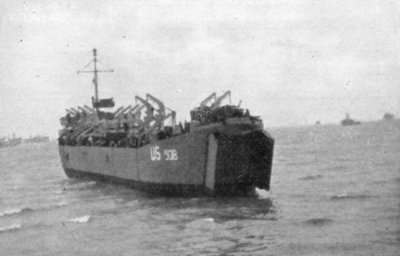 LST awaiting incoming tide at Utah Beach Greeting the Headquarters contingent that afternoon as its members stepped onto the soil of France was rain, a driving rain which developed into the best introduction the men could have been given to that country. It fell steadily from then on with intermissions, of course -- during the late summer, fall, winter and spring parts of the ETO campaign, and wet feet became as common as K rations. But Headquarters brought its own protection from sickness right along with it, for also on that rainy July 20 afternoon, in the words of Capt. Schmitt, "here came the pill-rollers!" |
|
They were All There - The pill-rollers, those individuals who had received their sharpshooting medals for shots administered with needles, the men who looked after the health of the command and battle casualties as well as sanitation in areas occupied by the various units of the battalion during combat, were right on the job. Those landing on the rainswept coast of France that memorable day, July 20, included Captain Schmitt, Staff Sgt. Raymond H. Grove, T-4 Alfred J. Tix, T-5's Alfred R. Bachtold and William Stewart, PFC's George S. Stotler and Ruby Brumer and Pvts. Clyde Walters and John Dohanos Jr. It took all kinds of soldiers to make an army, and that included the "chairborne infantry," Personnel Section's clerk-soldiers who sweated out VE day with the rest of the division through ten months of combat and 16 bivouacs. Almost immediately after landing with the rest of Battalion Headquarters, the Section was divorced from the battalion, reporting to the division's Rear Echelon for duty in the Administrative Center. Landing on July 20 were the following enlisted men of the Personnel Section: Tech. Sgt. Herbert S. Lear Jr., Personnel sergeant major; Sgt. John J. Eschenbacher, payroll clerk; Sgt. Allan J. McCutcheon, Company "C" clerk; Sgt. Edward D. Turnure Jr., Company "B" clerk; Alfred DeChristoforo, Company "A" clerk; T-4 Matthew C. Kuca, personnel clerk; T-4 Fagan R. Scott, clerk; T-4 Earl J. O'Brien, Headquarters Company clerk; T-5 Edward J. O'Connor, Battalion mail clerk; T-5 James W. Arthur, morning report clerk, and T-5 James S. Tresslar, clerk. Since Personnel was not authorized a warrant officer, the section operated with just the 11 aforementioned EM from July 20 until September 1 when Lt. Boch, Battalion Adjutant, came from Battalion Headquarters to remain with the section. Before that, he had come to the rear every few days to transact the recessary [necessary] personnel business required by his office. Also operating apart from the rest of the Battalion Headquarters group was Division Ordnance which maintained a "rolling ammunition dump" throughout the war. Arriving in France, all units of the division carried basic loads of ammunition, but when the mission became known, Capt. Rabon -- he was then a first lieutenant -- realized that the basic load would be insufficient for the operation. Knowing how fast an armored division moved, he set forth at once to have basic ammunition loads increased. Going to Eighth Corps Headquarters of the First Army under which the division was then operating, he talked for hours, even awakening the chief of staff in the middle of the night. Although the latter assured Capt. Rabon that the ammo dumps never would be more than five miles from the battalion, he convinced the chief of staff of the necessity for more ammo, and got the "go sign" to increase basic loads. Any questions relative to the duties of Division Ordnance were referred to its Pennsylvania lawyer, J. Donald "Squire" Steele who always maintained that his was a paid-up membership in the army's only "glorified bull gang." He further stated frequently that "war is hell when viewed from the lower left corner of a 300-pound box." A sufferer from misconceptions of those who draw up the army's tables of organization and equipment was Oris "Taters" Snyder who as classified as a typist and file clerk but who found himself occupied as a truck driver and chief tool box lifter. It seemed that the misguided souls responsible for the aforementioned T/O & E labored under the delusion that the army needed lots of clerks and no box handlers. No damage was sustained during the loading or unloading of Battalion Headquarters equipment, but Johnny Ryan never had to drive again after the staff watched him back a C & R car up the loading ramp of a ship at Southampton. |
|
First Bivouac - The first Normandy bivouac was located between hedgerows in the vicinity of Les Mesnil St. Martin, three miles south of Fierville where the personnel waddled around between showers for ten days and ate steadily of rations picked up on the LCT. It was here that "Bedcheck Charlie" introduced himself, and this lone Kraut recon plane making his late evening run became a regular feature of activities in France. 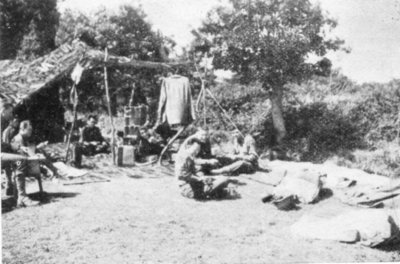 Administrative Center's first field bivouac near Fierville Battle noises could be heard easily in this bivouac, even by the lads in Administrative Center, a half mile from Fierville, which was located so near the front lines that men could watch night flashes from artillery barrages over the hills to the south of their area. Administrative Center was situated in the famous Normandy hedgerow country, and six fields were required to accommodate the entire Center. Good weather made the stay of the Headquarters group in the Fierville district a very pleasant one for everyone, and as long as the men were merely encamped there in the fields, life was not at all unpleasant. In Personnel Section, many midnight snacks were prepared before twilight. These would be followed by "barber shop" song sessions, Sgt. McCutcheon accompanying on his guitar. |
|
Into Action - However, there was a war to be fought, and developments affecting Battalion Headquarters were not long in coming. The battalion was alerted for movement on July 28, 1944, and its three letter companies left the area in support of combat commands of the division, the last letter company departing on July 30. On the rainy morning of that same day, Headquarters, with Headquarters Company, left as part of Division Trains, and proceeded to a new bivouac in the vicinity of Le Bingard, France, two and a half miles from that town. This was the first of a long series of moves leading through Normandy and around the Brest Peninsula. 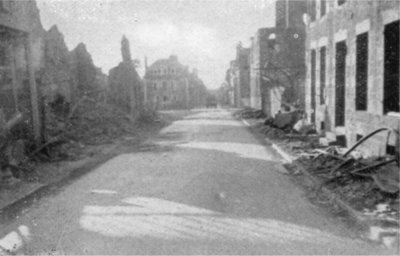 La Haye du Puits, as the battalion started moving 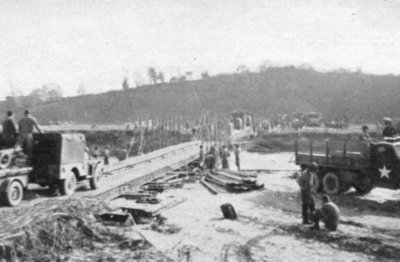 Streams were crossed one way or another Next morning, the Headquarters contingent moved on 14 miles to the vicinity of Montmartin-Sur-Mer where a bivouac was established five miles south of the town. But this stop only gave the men time to camouflage and dig in before the convoy got underway again, moving into a field three miles northwest of Avranches on the morning of August 1, after covering 52 miles of enemy-infested territory. The trip was made at night through a burning, stinking, battle-strewn area cluttered with wrecked and abandoned vehicles, burning buildings and ghost towns. This was warfare at a speed a little difficult to comprehend. The road leading by the Headquarters bivouac area was "trapped" with a crater large enough to hold a halftrack and cargo truck which dropped into it during the first night with resultant noise and confusion and little sleep for the personnel. Several "firsts" were marked here in the battalion's little black book during the first three days. The billeting party, consisting of Battalion S-2 and S-3 Captain Pilcer, Master Sgt. Thermon Funderburk, CWO William J. Fitzsimmons and Master Sgt. Tim Ream, accumulated a total of 22 prisoners by arriving at new areas before the Germans had time to leave. Here also Sgts. Jim Cottom and John Minnik of the Battalion S-4 Section began one of the more unpleasant tasks connected with warfare -- that of tagging and carrying bodies to a Quartermaster Graves Registration collecting point. |
|
Running the Gauntlet - And at this stage, those who might not have realized they were in a war rapidly became acquainted with the fact that "this was it!" For the Germans began in earnest. During the afternoon of August 1, the Luftwaffe bombed, strafed and fired rockets into the area in its first concentrated attack. Damage was confined entirely to the attacking force which lost two FW 190's to attached units of the 777 AAA Battalion accompanying Headquarters group. Little Jockey Kern had just finished his famous statement, "the day of the slit trench has passed," when the Krauts arrived, but 20 minutes later he had the deepest and fanciest hole in the place. Others engaged in some plain and fancy burrowing at this point, notably Maj. Stiteler who acquired something of a reputation as the best and fastest foxhole digger of the battalion, but Don Steele did not excavate sufficiently deep to gain full protection for his extra-large hips before the planes made their second run over the area, This first visit by forces of the enemy caused considerable excitement, and in that excitement some strange places were selected for cover. Funderburk, Ryan and Lt. Boch wound up in the bottom of a creek after plowing a hole wide enough for a truck through surrounding weeds. Ryan, at a loss without his glasses at the time, had to base his decisions and direction of flight on the noise reaching his ears. Suffering worst of all was Andy Reurink who had conscientiously dug a nice deep hole -- in a bad position, as it turned out. A multitude of visitors seeking Major Wood and Col. Graeves barely left any room at all in the hole for Andy. |
|
Avranches - For Battalion Headquarters personnel, as well as for the rest of the battalion, the most memorable action of the war occurred later that day and early the following morning -- August 1 and 2 -- when a 45-mile move was made through Avranches (and surrounding country when the column, became a bit lost) to a bivouac three miles north of La Croix. Traffic on the road was sufficient to make it appear that the entire American army was following the same route at the same time and attempting to cross the same small bridge just outside the town of Avranches. Added to all this was the fact that A. Hitler & Co. had aerial representatives on the spot to halt that movement. 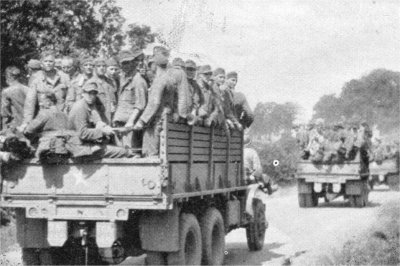 Part of the 2,100 German prisoners taken at Avranches This move had everything -- flares, ack-ack, bombs, confusion, noises which only war and the army can produce -- and Charlie Oliver sleeping through the whole business. Some maintained they were not scared at any time, but stomaches were doing flips, and Col. Graeves also did one at a ticklish moment. |
|
Brass on the Spot - The colonel and Maj. Wood were riding in the rear of the C & R car when something -- either a bomb or shell -- exploded near the vehicle on the colonel's side. "What in hell was that?" inquired the colonel, shaken either by nervousness or concussion or a combination of the two. "What in hell are you doing on my lap?" was the major's startling reply. A quick shift in the rear seat of the C & R restored the necessary military dignity, and the war went on. Major Wood soon thereafter found himself in a real dilemna[dilemma]. In fact, he found himself forced to choose between the horns of a "collaborationist" French bull and the bullets of the Luftwaffe. The major was attempting to unsnarl a traffic jam, and was out on the road directing the movement of vehicles when a representative of the Luftwaffe came strafing. Leaping across a hedgerow and behind a four-inch tree for protection from the plane's bullets, he found himself confronted by a hostile bull which promptly chased him back across the hedgerow. No sooner had he reached the "safety" of the road, however, than back came the strafing plane. Over the hedge went the major a second time, and there waited the bull again. He made it back to the road again after the plane had passed and before the bull reached him. This performance went on for awhile to the great agitation of Maj. Wood, the Luftwaffe and the bull taking turns chasing him back and forth over the hedgerow. But then everyone was having his own private troubles, Lt. Rabon included, at that time. He tells his as follows: "In the vicinity of Avranches while being strafed by enemy aircraft the ammunition train column which I was leading was shifted off the highway and halted. I took cover in an apple orchard to the right of a country road, and frightened though I was, I became aware of something moving against my stomach which wasn't me. On fearful investigation, I discovered a little black kitten which apparently was as much afraid of the enemy planes as I was. In consoling the kitten, I forgot all about the planes." 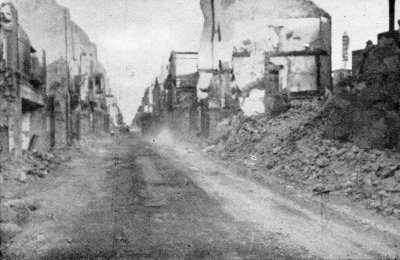 This was Avranches Digging was the most popular activity the minute the column pulled off the road, digging into the hardest, most discouraging mixture of clay and gravel ever to meet the business end of an army entrenching tool. More restless men did a little patrolling, collecting a few souvenirs for their efforts and bringing back evidence that current touring, to paraphrase a sign frequently seen in those days along roads, was through territory "cleared of enemy to the ditch and no further." Discovering that the date was August 2, Army Finance paid the boys - in their first francs. During that afternoon, the Luftwaffe returned for a repeat performance, driving the colonel into a pigsty for cover on one occasion and losing two more FW 190's to the AAA men who were developing into sharpshooters. Adolphus bird boys, still unconvinced that it was open season on them, came back again for an all-night performance, with still no damage to Battalion Headquarters -- only loss of sleep -- during the night of August 2 and 3. It fell to the lot of Maj. O'Hara to undergo not one but two days of bombing in the Avranches area, After "sweating out" the premier performance with the rest of the battalion, he came back the night after Battalion Headquarters had gone through the town. Passing through the old bivouac area just about dusk, he heard the now familiar fluttery roar, that ripping sound of strafing and the crash of bombs. Remembering his foxhole of the preceding day, the major made for it, but when he was in the hole, things looked so "hot" that he decided it did not offer sufficient protection. When a bomb exploded not very far from his position, he leaped out of the hole and took off across country, not on the double but at a dead gallop. The incident had a lucky ending, for, as was the case in so many Luftwaffe attacks upon battalion personnel, it was the old story -- no hits, a lot of running and all errors as far as the Nazis were concerned. |
|
Local Victories - Patrols of Battalion Headquarters and Headquarters Company encountered several small disorganized Groups of Germans in this area, and took them prisoner -- a total of 21 being bagged. On August 3, the next move covered 33 miles, without event, to a bivouac area six miles southwest of Becheral, and the following afternoon the column took off on another trip, 46 miles long, through enemy-occupied territory, to a bivouac 1.3 miles northwest of Noyal Pontivy. On this latter jaunt the column encountered its first enemy ground attack. A small German patrol attacked the vehicles and men of the convoy at a point where the battalion billeting party had passed a rough afternoon low down in a ditch. Again the battalion was lucky -- as it was many times during the war -- for damage was limited in this instance to a bullet hole through the engine hood of one of the Medical Detachmen [Detachment] trucks. Also, there were holes through several erring Heinies when it was finished. |